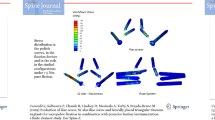Abstract
The development of iliac screws has provided a markedly easier way for spino-pelvic instrumentation than the classical Galveston technique. However, high rates of iliac screw loosening and breakage are usually reported, especially in cases where bilateral single iliac screws are used. Therefore, there is a need for exploring more stable iliac fixation techniques. Thus, the objective of this study was to compare the biomechanical effects of bilateral single and dual iliac screws on the stability of L3-iliac fixation construct under total sacrectomy condition. In this study, L2-pelvic specimens were harvested from seven fresh human cadavers. After biomechanically testing the intact state simulated by L3-L5 pedicle screw fixation, destabilization was introduced by total sacrectomy. Upon destabilization, L3-iliac screw-rod reconstructions were performed by four different techniques as follows: (1) bilateral single short iliac screws (Single-Short); (2) bilateral single long iliac screws (Single-Long); (3) bilateral dual short iliac screws, placed in the upper and lower iliac columns (Dual-UL); and (4) bilateral dual short iliac screws, all placed in the lower iliac column (Dual-Lower). These four iliac screw fixation techniques were sequentially preformed in the same specimen, and the lengths of the short and long iliac screws were 70 and 130 mm, respectively. Biomechanical testing was performed on a material testing machine under 800 N compression and 7 Nm torsion loading modes to evaluate the construct stiffness. In compression, the stiffness of the L3-iliac fixation constructs of Single-Short, Single-Long, Dual-UL, and Dual-Lower techniques were 73, 76, 98, and 108% of the intact state, respectively. No significant differences were detected between Single-Short and Single-Long (P = 0.589) techniques. However, the compressive stiffness of these two techniques was significantly lower than the intact state, and the Dual-UL and Dual-Lower techniques (P < 0.05). There was no statistical difference between the intact condition and the Dual-Lower technique (P = 0.109). Interestingly, Dual-Lower exhibited notably higher compressive stiffness than Dual-UL (+10.3%, P = 0.049). In torsion, the stiffness of Single-Short, Single-Long, Dual-UL, and Dual-Lower techniques were 72, 79, 105, and 109% of the intact condition, respectively. No significant differences were detected between Single-Short and Single-Long techniques (P = 0.338), and also among Dual-UL, Dual-lower techniques, and the intact state (P > 0.05). However, Single-Short and Single-Long techniques provided markedly lower construct torsional stiffness than the other three groups (P < 0.05). For lumbo-illiac reconstruction after total sacrectomy, even the use of bilateral single, long iliac screws do not help in restoring the local stability to the intact condition. However, dual iliac screws provide much higher construct stability than single iliac screw techniques. Therefore, dual iliac screw technique should be preferred for treating the unstable situation caused by total sacrectomy.






Similar content being viewed by others
References
Moshirfar A, Rand FF, Sponseller PD (2005) Pelvic fixation in spine surgery: historical overview, indications, biomechanical relevance, and current techniques. J Bone Joint Surg Am 87:S89–S106
Emami A, Deviren V, Berven S et al (2002) Outcome and complications of long fusions in adult spine deformity: luque-galveston, combined iliac and sacral screws, and sacral fixation. Spine 27:776–786
Tsuchiya K, Bridwell KH, Kuklo TR et al (2006) Minimum 5-year analysis of L5-S1 fusion using sacropelvic fixation (bilateral S1 and iliac screws) for spinal deformity. Spine 31:303–308
Zhang HY, Thongtrangan I, Balabhadra RS et al (2003) Surgical techniques for total sacrectomy and spinopelvic reconstruction. Neurosurg Focus 15:E5
Schildhauer TA, Bellabarba C, Nork SE et al (2006) Decompression and lumbopelvic fixation for sacral fracture-dislocations with spino-pelvic dissociation. J Orthop Trauma 20:447–457
Acharya NK, Bijukachhe B, Kumar RJ et al (2008) Ilio-lumbar fixation–the Amrita technique. J Spinal Disord Tech 21:493–499
Fujibayashi S, Neo M, Nakamura T (2007) Palliative dual iliac screw fixation for lumbosacral metastasis. technical note. J Neurosurg Spine 7:99–102
Mindea SA, Salehi SA, Ganju A et al (2003) Lumbosacropelvic junction reconstruction resulting in early ambulation for patients with lumbosacral neoplasms or osteomyelitis. Neurosurg Focus 15:E6
Berry LJ, Stahurski T, Asher MA (2001) Morphometry of the supra sciatic notch intrailiac implant anchor passage. Spine 26:E143–E148
Schildhauer TA, McCulloch P, Chapman JR et al (2002) Anatomic and radiographic considerations for placement of transiliac screws in lumbopelvic fixations. J Spinal Disord Tech 15:199–205
Miller F, Moseley C, Koreska J (1990) Pelvic anatomy relative to lumbosacral instrumentation. J Spinal Disord 3:169–173
Zheng ZM, Yu BS, Chen H et al (2009) Effect of iliac screw insertion depth on the stability and strength of lumbo-iliac fixation constructs: an anatomical and biomechanical study. Spine 34:E565–E572
Schwend RM, Sluyters R, Najdzionek J (2003) The pylon concept of pelvic anchorage for spinal instrumentation in the human cadaver. Spine 28:542–547
Akesen B, Wu C, Mehbod AA et al (2008) Revision of loosened iliac screws: a biomechanical study of longer and bigger screws. Spine 33:1423–1428
Yu BS, Zheng ZM, Zhuang XM et al (2009) Biomechanical effects of transverse partial sacrectomy on the sacroiliac joints: an in vitro human cadaveric investigation of the borderline of sacroiliac joint instability. Spine 34:1370–1375
Roig-Vilaseca D, Nolla JM, Roig-Escofet D (2000) Suitability of the T-score for establishing bone mineral density categories. Osteoporos Int 11:408–410
Acknowledgment
The authors would like to thank Medtronic-WeiGao Inc. for providing the posterior spinal fixation system. This study was supported by Guangdong Provincial Medical Research Foundation of China (A2008161 and 2008B050100012).
Author information
Authors and Affiliations
Corresponding authors
Rights and permissions
About this article
Cite this article
Yu, BS., Zhuang, XM., Zheng, ZM. et al. Biomechanical advantages of dual over single iliac screws in lumbo-iliac fixation construct. Eur Spine J 19, 1121–1128 (2010). https://doi.org/10.1007/s00586-010-1343-8
Received:
Revised:
Accepted:
Published:
Issue Date:
DOI: https://doi.org/10.1007/s00586-010-1343-8




